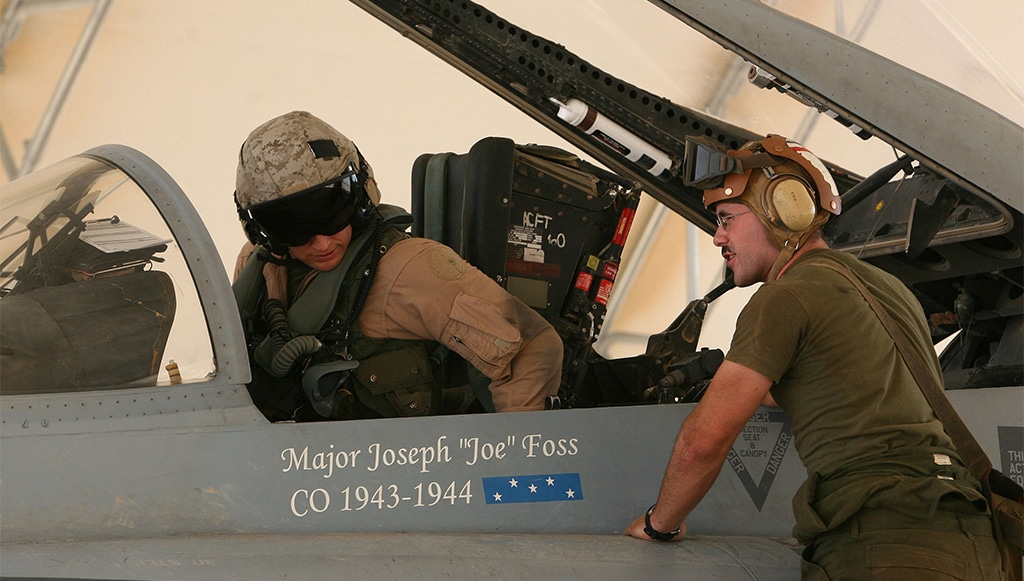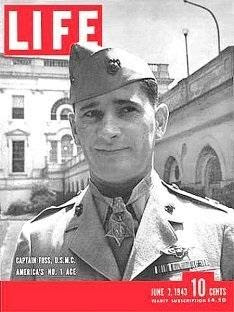“Ace of Aces,” Joe Foss


Captain Joe Foss, USMC, was a fighter pilot at Guadalcanal during WWII. Within five months of arriving at Henderson Field on Guadalcanal, Foss had shot down 26 Japanese fighter planes and bombers, tying the record of WWI ace Eddie Rickenbacker and earning the moniker “Ace of Aces.” Foss returned to the United States in March 1943, and on May 18, 1943, received the Medal of Honor from President Franklin Roosevelt. Foss’s Medal of Honor citation captures written accounts of his time at Guadalcanal.
For outstanding heroism and courage above and beyond the call of duty as executive officer of Marine Fighting Squadron 121, 1st Marine Aircraft Wing, at Guadalcanal. Engaging in almost daily combat with the enemy from 9 October to 19 November 1942, Capt. Foss personally shot down 23 Japanese planes and damaged others so severely that their destruction was extremely probable.
In addition, during this period, he successfully led a large number of escort missions, skillfully covering reconnaissance, bombing, and photographic planes as well as surface craft. On 15 January 1943, he added three more enemy planes to his already brilliant successes for a record of aerial combat achievement unsurpassed in this war. Boldly searching out an approaching enemy force on 25 January, Capt. Foss led his eight F4F Marine planes and four Army P-38s into action and, undaunted by tremendously superior numbers, intercepted and struck with such force that four Japanese fighters were shot down and the bombers were turned back without releasing a single bomb. His remarkable flying skill, inspiring leadership, and indominable fighting spirit were distinctive factors in the defense of strategic American positions on Guadalcanal.
Foss and his air group, called the “Cactus Air Force,” arrived at Guadalcanal on 9 October 1942. In his first combat mission, 13 October, Foss shot down a Japanese Zero, but his plane was damaged in the fight and with a dead engine in his aircraft, Foss landed at Henderson Field at full speed, no flaps, barely missing a stand of palm trees. On 7 November, Foss was shot down over the Pacific, surviving many hours in the water. He was rescued by a Marine in a large canoe manned by several natives of a nearby island, surviving his time in the water because of his Mae West life preserver, since the native of South Dakota couldn’t swim. During roughly three months of aerial combat, Foss and his squadron, known as “Foss’s Flying Circus,” shot down 72 Japanese aircraft, 26 of which were shot down by Foss himself, including the Japanese flying ace Kaname Harada, who Foss met after the war.
Foss was relieved of active duty in December 1945, but remained on inactive duty in the Marine Corps Reserve until 1947. During that time, in 1946, Joe Foss was appointed a lieutenant colonel in the South Dakota Air National Guard becoming commanding officer of the Guard’s 175th Fighter-Interceptor Squadron. During the Korean War, Col Joe Foss was recalled to active duty with the United States Air Force where he served in the Central Air Defense Command as Director of Operations and Training. He eventually became a brigadier general.
Following military service, Foss returned to his native South Dakota where he served several terms in the South Dakota House of Representatives. His performance there, and his fame as an American war hero, put him in position to become governor of South Dakota, serving two terms in that office. (Interestingly, Foss lost a run for a seat in the U.S. House of Representatives to fellow pilot George McGovern.) After leaving the governor’s office, Foss became the first commissioner of the American Football League. Foss worked to expand the league, making important television deals with ABC in 1960 to broadcast AFL games for $10.6 over five years, and in 1965, a 36 million-dollar contract with NBC for five years. For several years, including his time as AFL commissioner, Foss hosted a hunting and fishing program on ABC called The American Sportsman. In 1988, Foss served two consecutive one-year terms as president of the National Rifle Association.
Joe Foss died at 87 on January 1, 2003 in Scottsdale Arizona due to complications from a stroke suffered the previous October. He is buried at Arlington National Cemetery.

